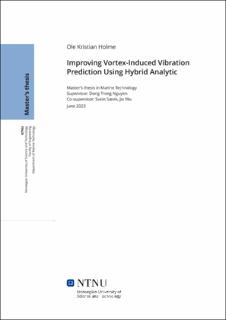| dc.contributor.advisor | Trong Nguyen, Dong | |
| dc.contributor.advisor | Sævik, Svein | |
| dc.contributor.advisor | Wu, Jie | |
| dc.contributor.author | Holme, Ole Kristian | |
| dc.date.accessioned | 2023-07-25T17:19:22Z | |
| dc.date.available | 2023-07-25T17:19:22Z | |
| dc.date.issued | 2023 | |
| dc.identifier | no.ntnu:inspera:140295966:34554246 | |
| dc.identifier.uri | https://hdl.handle.net/11250/3081329 | |
| dc.description.abstract | Prediksjoner av virvel-induserte vibrasjoner (VIV) er av stor betydning i design- og levetidsberegninger for slanke strukturer i havet. Modellene brukt i dag, har flere forenklinger som gjør at de ikke klarer å beskrive den komplekse fluid strukturen helt nøyaktig. Oppgaven har som mål å utforske potensialet ved å kombinere maskinlæringsteknikker med tids-domene modellen VIVANA-TD, for å forbedre VIV-prediksjonen. Først vil bakgrunnsteori for VIV og maskinlæring bli presentert. Deretter vil tilnærminger for å kombinere fysikk-baserte modeller med maskinlæring bli diskutert. Spesielt vil bruken av nevrale nettverk kombinert med tidligere kunnskap i form av matematiske modeller bli undersøkt.
Oppgaven utforsker videre metoden fysikk-baserte nevrale nettverk (PINN). PINN er et nevralt nettverk med et ekstra ledd i tapfunksjonen, som beskriver forskjellen på den fysikk-baserte modellen og prediksjonen til det nevrale nettverket. Denne metoden gjør det mulig å tilpasse seg måledata og samtidig som det er mulig å finne ukjente parameter i den fysikk-baserte modellen. Dette gjør at PINN kan benytte seg av matematiske modellene vi har i dag og forbedre dem med måledata. Metoden blir testet på to forenklet fysikk-baserte modeller.
Resultatet for PINN, er at metoden i noen tilfeller forbedrer prediksjonen. Men ved å inkludere et ekstra ledd i tapfunksjonen, blir optimaliseringen mer utfordrende. I noen tilfeller får modellen helt feil resultat. Dette er spesielt når parameterne i den matematiske modellen blir store. Ved å endre på strukturen i nevral nettverket blir metoden mer robust. Videre utbedring og forståelse av hvorfor det i visse tilfeller ikke fungerer, må gjøres for at det skal bli en effektiv metode. | |
| dc.description.abstract | Predictions of vortex-induced vibrations (VIV) are of great importance in design and lifetime calculations for slender structures in the ocean. The semi-empirical models used today are still considered simplified compared to the complex fluid-structure interaction. This thesis investigates the potential of combining machine learning techniques with the semi-empirical time-domain model VIVANA-TD to improve VIV prediction. The thesis begins by presenting the theoretical background of VIV and machine learning. Then, different approaches combining physics-based models with machine learning will be discussed.
Furthermore, the thesis investigates how Physics-informed Neural Networks (PINNs) can improve predictions by incorporating mathematical models and measurement data. PINNs introduce an additional term in the loss function that describes the difference between the predictions of the neural network and the physics-based model. This approach enables the discovery of a solution that aligns with the mathematical model. Moreover, the approach facilitates the adjustment of unknown parameters within the physics-based equations, leading to a model that satisfies both the measurement data and the mathematical model. Two simplified problems are used to evaluate the method.
Results from the simplified problems demonstrate its potential to improve mathematical models by incorporating measurement data. However, the optimization process becomes more complex due to an additional physics-based term in the loss function of the neural network. Especially when the parameters of the mathematical models are large, the model fails to converge to the correct solution. Although modifying the neural network's structure improves its ability to converge to the correct solution, further improvements and understanding are necessary for it to become a practical and effective method in engineering. | |
| dc.language | eng | |
| dc.publisher | NTNU | |
| dc.title | Improving Vortex-Induced Vibration Prediction Using Hybrid Analytic | |
| dc.type | Master thesis | |
